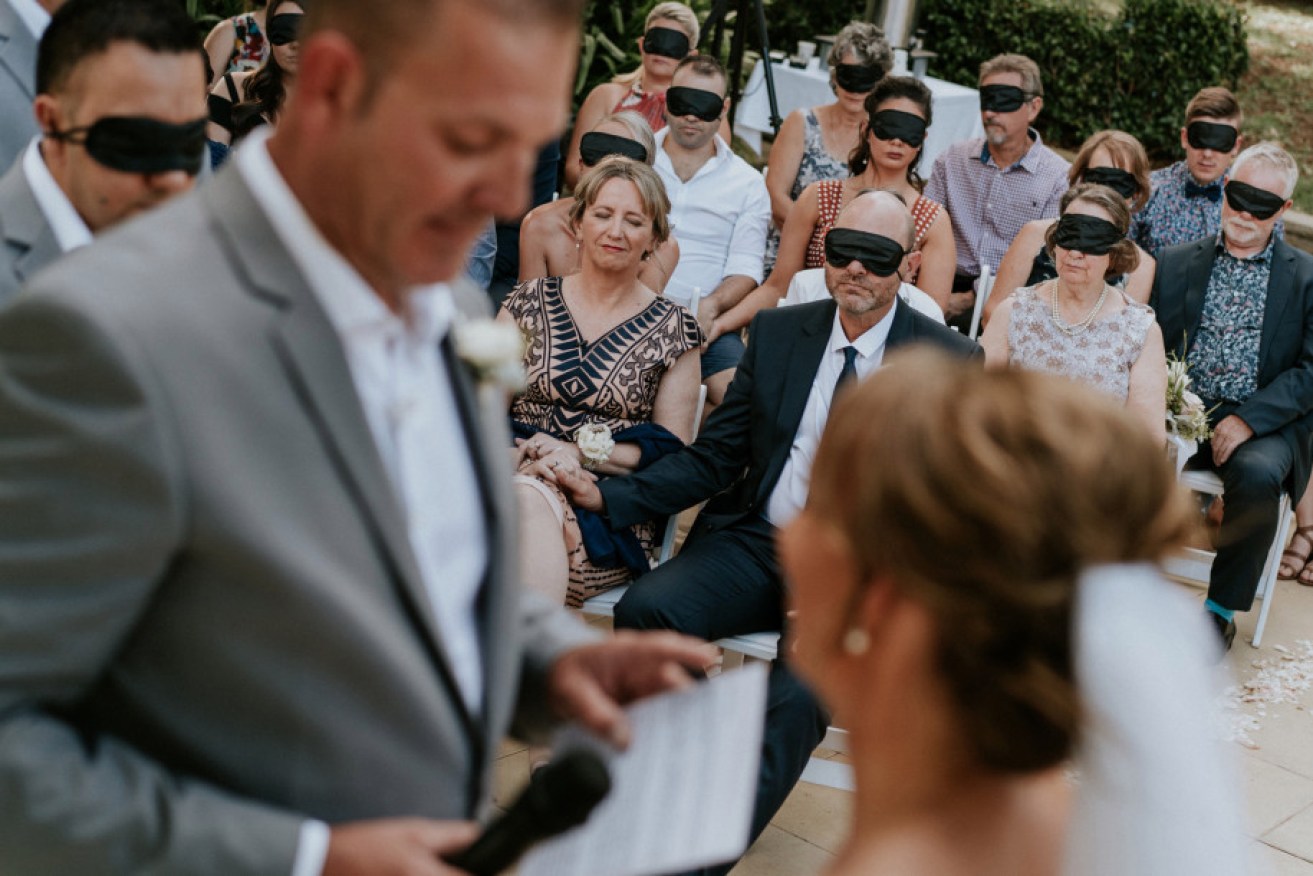The rare condition behind touching Australian wedding that went viral


Guests wore blindfolds during Steph and Rob's wedding ceremony Photo: James Day
Last week, a touching story about guests wearing blindfolds at a wedding ceremony held on the Sunshine Coast warmed hearts around the world.
The bride Stephanie Agnew, 32, lost her sight at the age of 27 to a rare inherited condition called cone-rod dystrophy – just shortly before meeting her groom Rob Campbell.
People with this condition experience vision loss over time. Symptoms often include loss of sharpness, clarity of vision (acuity), abnormal sensitivity to light, poor night vision or colour vision, and loss of peripheral vision.
Optometrist Luke Arundel told The New Daily that cone-rod dystrophy is a group of inherited eye disorders that affect light sensitive cells.
“At the back of the eye is a light-sensitive layer called the retina. This functions the same way as film in a camera and is made up of cells called rods for night vision, and cones for colour and daytime vision,” he said.
There is no cure, though some treatments may slow the degenerative process.
Steph and Rob lived next door to each other for 18 months but didn’t meet until a drinks function when Steph had already lost most of her vision.

The Queensland couple met shortly after Steph lost her eyesight. Photo: James Day
“He smelt of nice aftershave and I could feel he was wearing a blazer and jeans, so I knew he was well dressed,” Steph told New Idea earlier this year.
“I know his build … he is a lot taller than me, and I know he has broad shoulders, but other than that I have to rely on descriptions.”
When the couple got engaged, they knew they wanted to add tactile elements to the wedding so that Steph and other family members with the condition could feel more involved with the ceremony and reception.

Steph’s mum, who also has the condition, admiring the detail of the dress. Photo: James Day
The wedding venue was on the same road as Steph’s great aunt’s house with a view over the Glasshouse Mountains, which Steph remembers seeing as a child.
“She was able to picture the view on the day,” wedding photographer James Day said.
Steph’s bouquet was made up of fragrant flowers, and during the ceremony Steph organised an owl to fly down the aisle and land on her arm to deliver the rings.
Life with an inherited retinal disease
Retina Australia chairman Leighton Boyd is now blind after being diagnosed with a genetic eye disorder known as retinitis pigmentosa. It is the leading cause of inherited blindness, and like other types of cone-rod dystrophy, there is currently no cure.
He told The New Daily that life with a retinal disease is about making small adjustments each day.
“As patients we need to just move on with life. Because our eyesight is degenerating, we need to constantly make adjustments,” he said.
“Some people can feel a little isolated because they’ve lost their vision and can no longer go out by themselves like they used to.
“It’s about trying to make yourself as independent as much as you can [as the condition progresses].
“They might need to use some aids like canes to assist with their mobility. Later down the track, they might need to use computer software to assist them in making themselves more independent.”
Mr Boyd said telling friends and extended family about the gradual vision loss can be difficult, but support groups such as Retina Australia are available for help.
Low-vision services through Vision Australia are also available. The organisation can also assist individuals to register with the NDIS or My Aged Care to fund these services.
“Individuals can have a functional vision assessment by an orthoptist to understand how the individual is seeing and record any change over time,” Vision Australia’s regional practice leader and orthoptist, Virginia McDonald said.
“The orthoptist can also prescribe specialist fit-overs to reduce glare, and optical and digital magnification aids, including wearable technology.”
Is it common in younger people?
Cone-rod dystrophy is thought to occur in around 1 in 40,000 people, but some global estimates suggest one in 3500 could be affected.
The age of onset can vary greatly, but according to experts, some patients are affected from birth.
“There are over 30 types of CRD and it is caused by mutations in several different genes which can be inherited in many different ways,” Mr Arundel said.
“It is often diagnosed in the first decade of life with legal blindness reached before 20 years of age,” he said.
Reduced sharpness and intense glare-sensitivity, which cannot be corrected with glasses, are usually the first signs of the problem when a child is primary school age, Ms McDonald explained.
“Individuals are often severely visually impaired or legally blind by the end of high school and second decade of life.
“Check your family history to see whether there is a history of blindness early in life and have regular eye health checks,” she said.
Useful links
Retina Australia – retinaaustralia.com.au
Good Vision for Life – goodvisionforlife.com.au
Vision Australia – visionaustralia.org
National Disability Insurance Scheme (NDIS) – ndis.gov.au/people-disability








